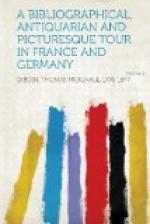[81] ["I know perfectly well, says M. Licquet, the
little Inn of which the
author here speaks. I
can assure him that it never formed any portion
of the “chapter house.”
It was nevertheless une dependance
exterieure (I will not
attempt a version of this phrase) of the
abbey. Dare I venture
to say it was the cowhouse? (etable aux
vaches). Thank you, good
Mons. Licquet; but what is a cow-house but
“an outer building
attached to the Abbey?” Vide supra.]
[82] [The heart and entrails only of this once celebrated
woman were,
according to M. Licquet, buried
in the above spot. The body was
carried to Loches: and
BELLEFOREST (Cosmog. vol. i. Part ii.
col. 31-32. edit. 1575, folio)
gives a description of the mausoleum
where it was there entombed:
a description, adds M. Licquet, which may
well serve for the mausoleum
that was at Jumieges.]
[83] [Not the smallest portion or particle of a sigh
escapes us, on being
told, as my translator has
told us, that the “soil” in question has
become the property of another
Owner. “Laius EST MORT”—are
the
emphatic words of M. Licquet.]
[84] [One of the bells of the Abbey of Jumieges is
now in the Tower of that
of St. Ouen, at Rouen. LICQUET.]
LETTER X.
CAUDEBEC. LILLEBONNE. BOLBEC. TANKARVILLE.
MONTMORENCI CASTLE. HAVRE DE
GRACE.
My last concluded with our entrance into Caudebec. The present opens with a morning scene at the same place. For a miracle I was stirring before nine. The church was the first object of attraction. For the size of the place, it is really a noble structure: perhaps of the early part of the sixteenth, or latter part of the fifteenth century.[85] I speak of the exterior generally, and of a great portion of the interior. A little shabby green-baise covered door (as usual) was half open, and I entered with no ordinary expectations of gratification. The painted glass seemed absolutely to warm the place—so rich and varied were its colours. There is a great abundance of it, and especially of figures of family-groups kneeling—rather small, but with great appearance of portrait-like fidelity. They are chiefly of the first half of the sixteenth century: and I own that, upon gazing at these charming specimens of ancient painting upon glass, I longed to fix an artist before every window, to bear away triumphantly, in a portfolio of elephantine dimensions, a faithful copy of almost every thing I saw. In some of the countenances, I fancied I traced the pencil of LUCAS CRANACH—and even of HANS HOLBEIN.




